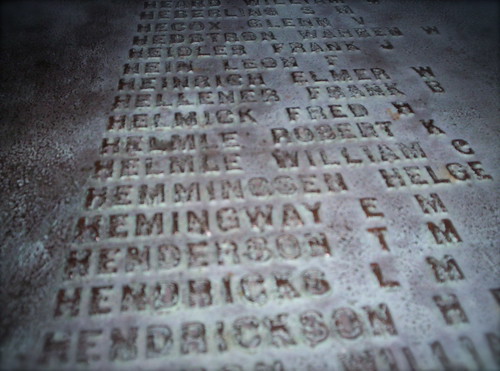
Ernest Hemingway's name on the World War I monument in Scoville Park, Oak Park IL. by Oak Park Cycle Club on flickr.
When I was in the fifth grade, they made us read Old Man and the Sea. I’ve hated Hemingway ever since.
It’s too bad really. I liked The Killers enough to watch two versions of it on consecutive nights. And he was an impressive character in William Kennedy’s novel, Changó’s Beads and Two-Tone Shoes. His work must have something going for it for him to be one of the titans of modern literature.
So I had mixed feelings going into In Our Time. The back cover refers to it as a collection of short stories, but they seem less like short stories than vignettes of varying length. And it feels less like a collection than a collage, or a sequence. The scenes, though sometimes unrelated, fit together to say something larger than the sum of the parts.
I see the connection between Hemingway’s simple straightforward “just the facts” writing and hardboiled fiction. Ellroy probably took the style to an extreme with his increasingly pruned language starting with LA Confidential. I wonder if Hemingway’s style was in part a reaction to his time. The beginning of the twentieth century saw life quickly going from a gas-lit, horse and buggy world to cars and planes and electricity and radio. In those circumstances, lives would have gotten busier, the pace faster, and Hemingway’s sparse style would have been a natural fit. In our own time, life is even busier, and we’re sending messages in 140 characters and telling stories in six words.
Besides my fifth grade experience, the other thing I think of when Hemingway is mentioned is this annoying 80s synth-pop. Enjoy.


Paul,
So I am really wondering how you liked In Our Time. This is the third or fourth time I read it, and I have to say it was the best for me yet, I will be writing a much longer post on my experience this time around, but I wanted to respond here to a few things you wrote.
First, Hemingway in undergrad for me was hard to swallow. I liked In Our Time and The Sun Also Rises enough, but I also didn;t necessarily marvel at the style. It all seemed so curt and easy, but this time around that is what grabbed me, it is all so effortless, and in each sentence there is a novel he refuses to tell, but it just seems to work on you, but I will go through this in more detail in my post.
While reading up for this book, one critic noted that Hemingway’s job as a foreign correspondent, and the dependence on the wire as a technology for sending back stories reenforces your vision of the technology and the collision of histories, moment, and visions. I tend to think that is what is happening now as well with the internet.
For me the striking thing this time around is how young Hemingway is when he nails these stories 23 or 24 years old. So crazy, he has a such an old soul frame for loss and the horro of being emotionally empty. What’s more, there is a constant sense of post-war trauma that plays itself out in almost every vignette and story. The loose, fragmented, impressionistic stories work together well in a kind of cubist, refractionary way. Anyway, I have much more to say, but I just wanted to let you know how much I enjoy your reflections on all things noir, the Ellroy idea of taking this all to the limit is right on, and for me he is the best of the lot as of late.
I enjoyed the book. It’s interesting that you call it cubist, because I think Cubism was more or less contemporary to In Our Time. By showing us a bunch of vignettes instead of a traditional story, he gives us a greater picture of his subject than we would get from a straight-on, linear presentation. But the views presented by Cubism are often jarring and more difficult to deal with.
The Battler was a standout for me. I’m not sure why. Maybe it’s because I’ve known too many crazy, potentially dangerous people. We end up being friends of sorts, then I realize that they aren’t the best people to associate with because they could snap at any time, for no sane reason. That one’s going to end up on Cafe Press, probably.
An old painting teacher of mine used the metaphor of a painting as a mirror: We see in it what we bring to it. I think that applies to any work of art. So when I read Hemingway as a ten year old, I probably didn’t have as much to bring to it as I do now. The fact that I HAD to read about this old man didn’t help, especially when I would have rather been reading about Batman or the Avengers.
Pingback: 6x6x6: In Our Time as told through T-Shirts | bavatuesdays